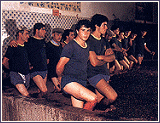Stomp, Portuguese style
 You know that caricature of someone in a vat, crushing grapes by foot to start the fermentation process? You know, the image long-ago phased out in practice for wine? Well, it turns out that nothing beats the foot in Portugal for making port.
You know that caricature of someone in a vat, crushing grapes by foot to start the fermentation process? You know, the image long-ago phased out in practice for wine? Well, it turns out that nothing beats the foot in Portugal for making port.
Only two percent of all port is still foot-crushed and it is mostly the best ports available, vintage ports. Despite some negative associations, feet are especially good at crushing the skin without crushing the seed–filled with bitter tannins–as well.
Electricity came late to the upper Douro Valley. When it did, in the 1980s, labor prices were high so producers rushed to adopt automated crushing and stainless steel closed-top fermenters. Quality fell. There was just something about those feet. Or oxygen.
The traditional lagares are made of granite and are wide, open-top vats or troughs. Somehow the exposure to oxygen provided a slight degree of oxidation that was more appealing in port, a fortified wine. David Fonseca Guimaraens told me today that his company, the Fladgate Partnership, was among the first in the region to develop mechanized foot-like pistons in open-top stainless steel vats. I didn’t ask if the pistons had toes. But Guimaraens did say that the added labor of foot crushing made it twice as expensive as mechanization.
 I tasted a sample of each of the three methods, foot-trodden from a stone lagar, piston-trodden in a stainless steel tank, and closed top.
I tasted a sample of each of the three methods, foot-trodden from a stone lagar, piston-trodden in a stainless steel tank, and closed top.
The last one was quite hollow in the middle with elevated, aggressive tannins. The piston-pressed one was much more complete, with a beginning a middle and an end with good freshness. But it was the lagar sample that had the most layers of complexity. Then there was a blind sample just to see if I was paying attention. Fortunately I got it right (the odds were good though).
In the ongoing discussion about wine and technology, it’s a cute story of the advantages of simplicity. But technology is on the march. Guimaraens says in five years, the pistons could catch the feet. They’d better keep running.




On March 27th, 2007 at 10:35 pm ,Derrick Schneider wrote:
So only vintage ports are foot-pressed. But isn’t a vintage only declared after the fruit has fermented?
So in non-vintage years, some foot-pressed port must be in regular port, right?
On March 27th, 2007 at 11:10 pm ,Mark Ashley wrote:
As the onetime Senior Free Wine Correspondent for DrVino.com, I feel it’s my moral duty to point out that port tastings at Taylor’s in Porto are free. Which I only learned today, here:
http://www.portocityguide.com/2007/03/26/taylors-fladgate-port-wine-winery-restaurant/
On March 28th, 2007 at 6:53 am ,Dr. Vino wrote:
Derrick,
True enough!
Mark,
Thanks for returning to your beat with that info!
Cheers,
On April 5th, 2007 at 12:07 pm ,Dr Vino’s wine blog » Blog Archive » The elusive green ruby: Fonseca organic port wrote:
[…] is pleasantly balanced between sweet and acid as well as being luscious–thanks to the advances in automated crushing, no doubt, since it is piston fermented–and the finish long and sweet. it’s the […]
On May 20th, 2007 at 9:17 pm ,David H wrote:
There is something romantic, something primal, something joyfull about wine made in the ancient method of foot treading. It seems something pure and almost magical that a machine will never duplicate. People and wine are at one from start to finish, only interrupted while it waits in the bottle. Does it get any better? Cheers!
On June 19th, 2008 at 4:28 pm ,Croft Port - 1945, 1960, 2003 | Dr Vino's wine blog wrote:
[…] installed automated stomping machines and, as I posted last year, when it comes to port, nothing beats the foot. When The Fladgate Partnership purchased Croft in 2001 to bring it under the same ownership as […]
On October 7th, 2008 at 3:24 am ,Treading Grapes in the Lagar - Traditional Vinification in the Douro wrote:
[…] lagar. The first time was last year, with the same friends but in Quinta de Ventozelo. Some people prefer the wines from this traditional method of vinification, others say the results are similar when compared to fermentation in a tank with mechanical […]